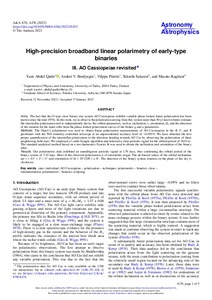High-precision broadband linear polarimetry of early-type binaries
Sakanoi Takeshi; Kagitani Masato; Qadir Yasir A; Berdyugin Andrei V; Piirola Vilppu
https://urn.fi/URN:NBN:fi-fe2023041235942
Tiivistelmä
Aims. The fact that the O-type close binary star system AO Cassiopeiae exhibits variable phase-locked linear polarization has been known since the mid-1970s. In this work, we re-observe the polarization arising from this system more than 50 yr later to better estimate the interstellar polarization and to independently derive the orbital parameters, such as inclination, i, orientation, Omega, and the direction of the rotation for the inner orbit from the phase-folded polarization curves of the Stokes q and u parameters.
Methods. The Dipol-2 polarimeter was used to obtain linear polarization measurements of AO Cassiopeiae in the B, V, and R passbands with the T60 remotely controlled telescope at an unprecedented accuracy level of similar to 0.003%. We have obtained the first proper quantification of the interstellar polarization in the direction heading towards AO Cas by observing the polarization of three neighboring field stars. We employed a Lomb-Scargle algorithm and detected a clear periodic signal for the orbital period of AO Cas. The standard analytical method based on a two-harmonics Fourier fit was used to obtain the inclination and orientation of the binary orbit.
Results. Our polarimetric data exhibited an unambiguous periodic signal at 1.76 days, thus confirming the orbital period of the binary system of 3.52 days. Most of the observed polarization is of interstellar origin. The de-biased values of the orbital inclination are i = 63. + 2. /-3. and orientation of Omega = 29.(209.) +/- 8.. The direction of the binary system rotation on the plane of the sky is clockwise.
Kokoelmat
- Rinnakkaistallenteet [19218]
